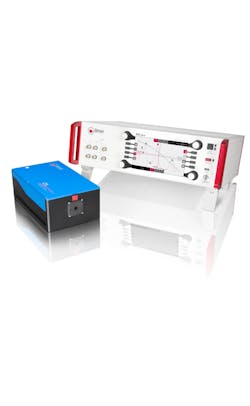TOPTICA Photonics will present their latest laser innovations at the 2017 Spring Meetings of the Deutsche Physikalische Gesellschaft. Come by for a visit to talk to our experts and learn more about the new products that support a variety of applications in quantum technology, biophotonics and materials measurement:
- From March 7th to 9th at the University of Mainz during the meeting of the Atomic, Molecular, Plasma Physics and Quantum Optics Section (SAMOP) at the booth Philosophicum 21 & 22.
- From March 21st to 23rd at the Technische Universität Dresden during the meeting of the Condensed Matter Section (SKM) at the booth Zelt A 89.
The widely tunable diode laser CTL is now available at new central wavelengths: 1050, 1320 and 1470 nm. These complement the coverage of the CTL that is also available at 950, 1500 and 1550 nm. It provides up to 110 nm mode-hop-free tuning with up to 80 mW output power and it supports wavelength scans with high absolute accuracy and resolutions as high as 5 kHz. The CTL is ideal for applications like spectroscopy, microresonators and microcombs, quantum dots, waveguide characterization, amplifier seeding, as well as testing of fiber components.
The new DLC DFB pro laser systems combine the ease-of-use and ruggedness of distributed-feedback diodes with the outstanding features of TOPTICA’s DLC pro laser controller. Owing to the digital architecture, this system is ideal for spectroscopic applications: It enables zooming in onto a signature of interest and permits frequency locking with just a few touchscreen gestures. In addition, a new “wide-scan” feature enables large scan ranges attainable with thermally tuned DFB diodes (more than 1000 GHz at selected near-infrared wavelengths).
TOPTICA’s low-noise frequency comb DFC is based on difference frequency generation that results in an unprecedented high phase stability of less than 32 mrad in a spectral interferometry measurement. The DFC CORE is available with up to 8 outputs at 1560 nm. Each output can be converted to any desired wavelength in the range of 420 – 2200 nm using special extensions. TOPTICA is able to provide complete stabilized laser systems including the DFC CORE, wavelength extensions, beat units, stabilization electronics, wavelength meters, counters and diode lasers. This is ideal for experiments that require a reliable reference for optical frequencies like atomic clocks and high-resolution spectroscopy. Moreover, the new member of the DFC family, the DFC SEED, is the first choice for all CEP-stable amplifier seeding applications.
The new FemtoFiber dichro midIR provides femtosecond laser pulses with a broadband tunable mid-infrared spectrum ranging from 5 to 15 µm at 80 MHz repetition rate and more than 0.5 mW output power. The mid-IR radiation is generated by difference frequency generation (DFG) of the fundamental beam and a frequency shifted beam. Since both beams originate from the same Er-doped fiber oscillator they are intrinsically synchronized down to the attosecond level. This guarantees most efficient and stable mid-IR generation. The FemtoFiber dichro midIR is a unique tool for spectroscopy or chemical analysis of materials with nanoscale resolution accuracy, e.g. in near-field spectroscopy systems.
The FemtoFiber ultra 1050 is the most recent addition to TOPTICA’s third generation of ultrafast fiber lasers. It provides powerful pulses centered at 1050 nm with > 5 W average power and 80 MHz repetition rate. The pulse duration of less than 120 fs is one of the shortest currently available on the market at this wavelength. The FemtoFiber ultra 1050 is ideally suited for multiphoton (SHG) microscopy, supercontinuum generation, material processing, as well as OPCPA or amplifier seeding.
